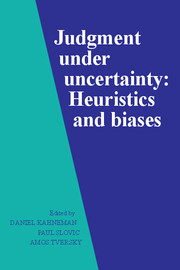Book contents
- Frontmatter
- Contents
- List of contributors
- Preface
- Part I Introduction
- Part II Representativeness
- Part III Causality and attribution
- Part IV Availability
- Part V Covariation and control
- 15 Informal covariation assessment: Data-based versus theory-based judgments
- 16 The illusion of control
- 17 Test results are what you think they are
- 18 Probabilistic reasoning in clinical medicine: Problems and opportunities
- 19 Learning from experience and suboptimal rules in decision making
- Part VI Overconfidence
- Part VII Multistage evaluation
- Part VIII Corrective procedures
- Part IX Risk perception
- Part X Postscript
- References
- Index
18 - Probabilistic reasoning in clinical medicine: Problems and opportunities
Published online by Cambridge University Press: 05 May 2013
- Frontmatter
- Contents
- List of contributors
- Preface
- Part I Introduction
- Part II Representativeness
- Part III Causality and attribution
- Part IV Availability
- Part V Covariation and control
- 15 Informal covariation assessment: Data-based versus theory-based judgments
- 16 The illusion of control
- 17 Test results are what you think they are
- 18 Probabilistic reasoning in clinical medicine: Problems and opportunities
- 19 Learning from experience and suboptimal rules in decision making
- Part VI Overconfidence
- Part VII Multistage evaluation
- Part VIII Corrective procedures
- Part IX Risk perception
- Part X Postscript
- References
- Index
Summary
To a great extent, the quality and cost of health care are determined by the decisions made by physicians whose ultimate objective is to design and administer a treatment program to improve a patient's condition. Most of the decisions involve many factors, great uncertainty, and difficult value questions.
This chapter examines one aspect of how these decisions are made, studying the use of probabilistic reasoning to analyze a particular problem: whether to perform a biopsy on a woman who has a breast mass that might be malignant. Specifically, we shall study how physicians process information about the results of a mammogram, an X-ray test used to diagnose breast cancer. The evidence presented shows that physicians do not manage uncertainty very well, that many physicians make major errors in probabilistic reasoning, and that these errors threaten the quality of medical care.
The problem
A breast biopsy is not a trivial procedure. The most common type (around 80%) is the excisional biopsy, in which the suspicious mass is removed surgically for microscopic examination and histological diagnosis by a pathologist. Usually the patient is admitted to a hospital and given a full set of preoperative diagnostic tests. The biopsy is almost always done under general anesthesia (with a probability of approximately 2 out of 10,000 of an anesthetic death).
- Type
- Chapter
- Information
- Judgment under UncertaintyHeuristics and Biases, pp. 249 - 267Publisher: Cambridge University PressPrint publication year: 1982
- 284
- Cited by



